One could argue that the onion is the most useful vegetable at our disposal. Not only do they grow in almost every gardening zone, they also hold a vast array of health benefits within their layers. With a powerful flavor that compliments almost any dish and a variety of ways to serve, onions are a fantastic homesteading crop.
I have recently learned an exciting new skill: preservation through dehydrated onions and making homemade onion powder. Today I want to share with you my trial-and-error analysis, as well as a step-by-step guide for you to create this flavor-packed seasoning in your kitchen!
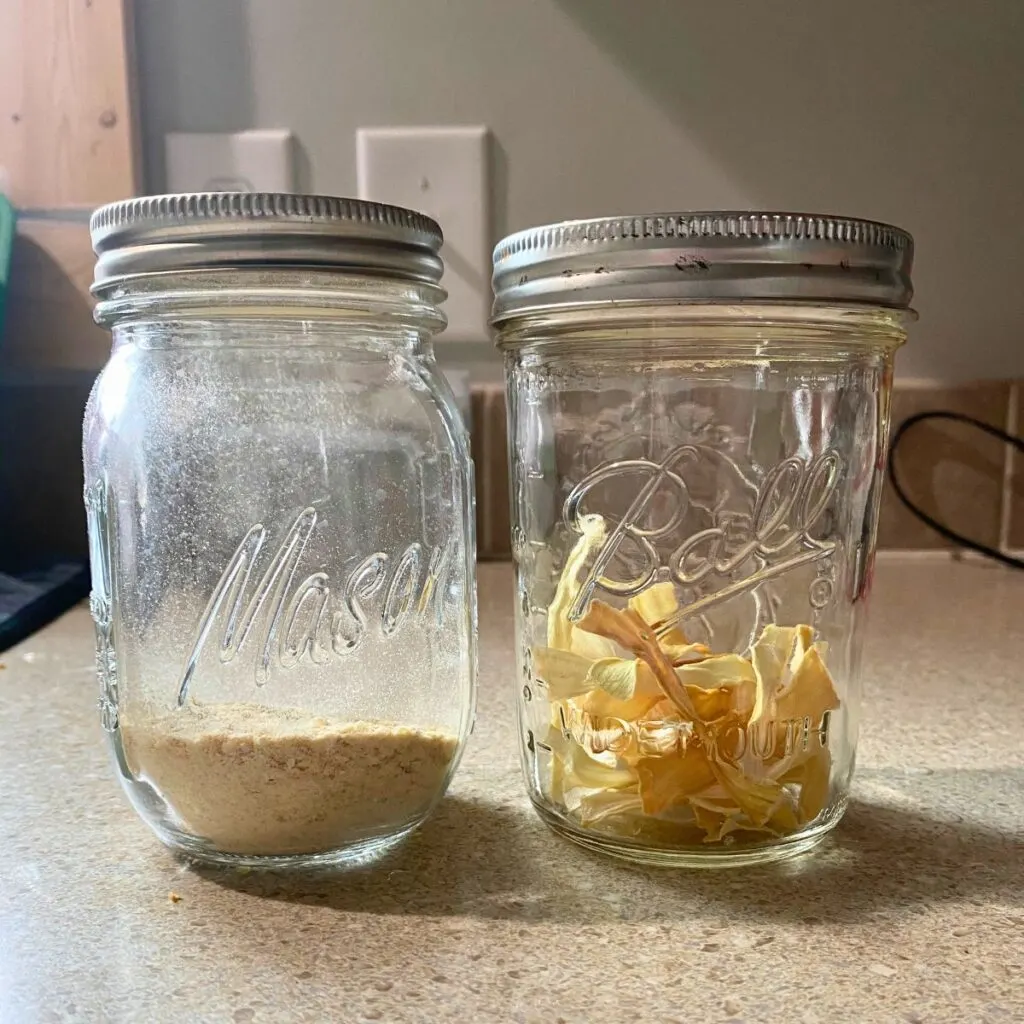
Health Benefits of Onions
We at City Folk Homestead have increased our onion intake drastically since moving to our homestead. Fresh onions are known for their amazing health benefits, including prebiotics, antioxidants, and sulfur. These nutrients are all great as natural antibiotics and for cancer prevention. Whenever we are sick, I up our onion (and garlic) intake for their natural health-boosting properties. Also, they’re just so delicious in a comforting soup or flavor-packed pasta sauce!
Have you wondered how to get those health benefits transferred to your spice cabinet? Are you looking for new ways to keep your onions stored longer? What about learning more food preservation skills and want to build a greater arsenal for one of nature’s best immunity-boosting vegetables? Then you need to try dehydrated onions!
You may be curious on what other uses for dehydrated onions are other than onion powder. I will explain those briefly at the end of this post, but first, I will be discussing a great way to create homemade onion powder that can be used in all of your favorite recipes—without worry about any additives or where the onion powder came from!
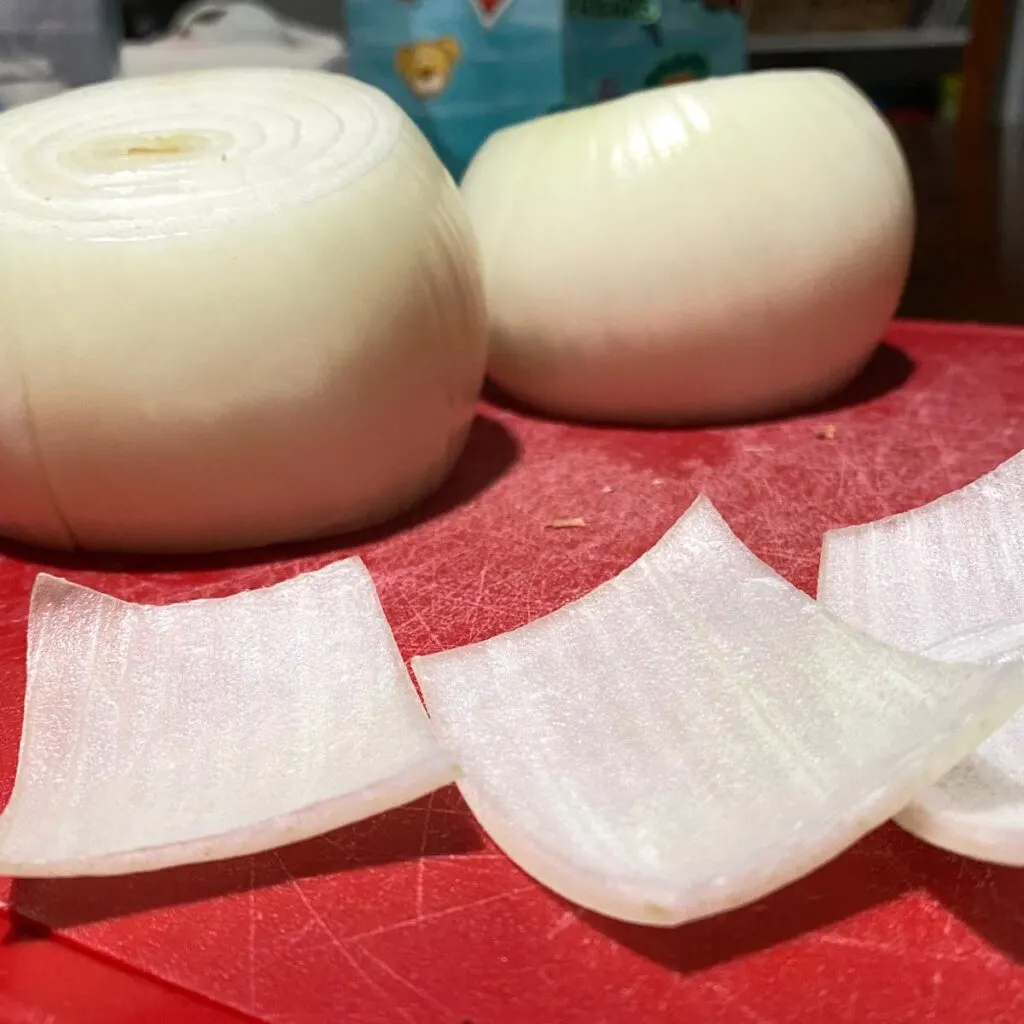
Preparing to Make Homemade Onion Powder
When making your own version in place of store-bought onion powder, feel free to get creative and experiment with different kinds of onions to see which has the best taste and storage life for your family’s needs. Some people even use the onion skins as a great addition to their dehydrated onions, while others stick to red onions, walla walla, yellow onions, or even sweet onions. If you are concerned most with the health benefits of onions, then you will want to dive deeper into the individual nutrition and benefits of each variety as there are differences.
According to Dr. Axe in “Onions: Onion Nutrition Benefits the Heart, Bones & More (+Onion
Recipes),” yellow onions have notable health benefits above the others. Another interesting note for the health gurus out there, this article also states that when an onion is cut and left open to air for around ten minutes, the onion’s phytonutrients are increased. So, if you are preparing onions for homemade onion powder with the maximum health benefits in mind, then this is definitely the “recipe” for you!
Ingredients
Onions of your choice – I chose to use yellow onions for this project
Tools
- Sharp knife
- Dehydrator
- Parchment paper (if desired) – used to line the dehydrator trays if you are concerned about the scent permeating the trays and leaching into other dehydrated goods
- Glass airtight jars with lids and rings – or other airtight storage container
- Blender or food processor – I suggest having one dedicated specifically to projects like onions, garlic, crushing up eggshells, etc. Others have suggested the use of a coffee grinder, but I would worry about the smell lingering and leaching into other foods
How to Make Homemade Onion Powder
My first time making onion powder was a bit of an experiment. I did multiple batches for this post because I wanted to give as many details as possible and troubleshoot potential issues for those who are doing this for the first time. In all, it took me five tries to get the drying time consistent and to determine whether larger pieces or small pieces of onion were better for the final product. I am still new to dehydrated food and therefore wanted to analyze if different ways of processing before dehydrating made any impact on the dried onion pieces.
I will forewarn and note that the smell of onions in the dehydrator can create quite the smell. I love the smell of onion, and still it was pretty overpowering. I would suggest moving your dehydrator outside during the process if at all possible. We kept the dehydrator in the garage and could still smell it inside our home.
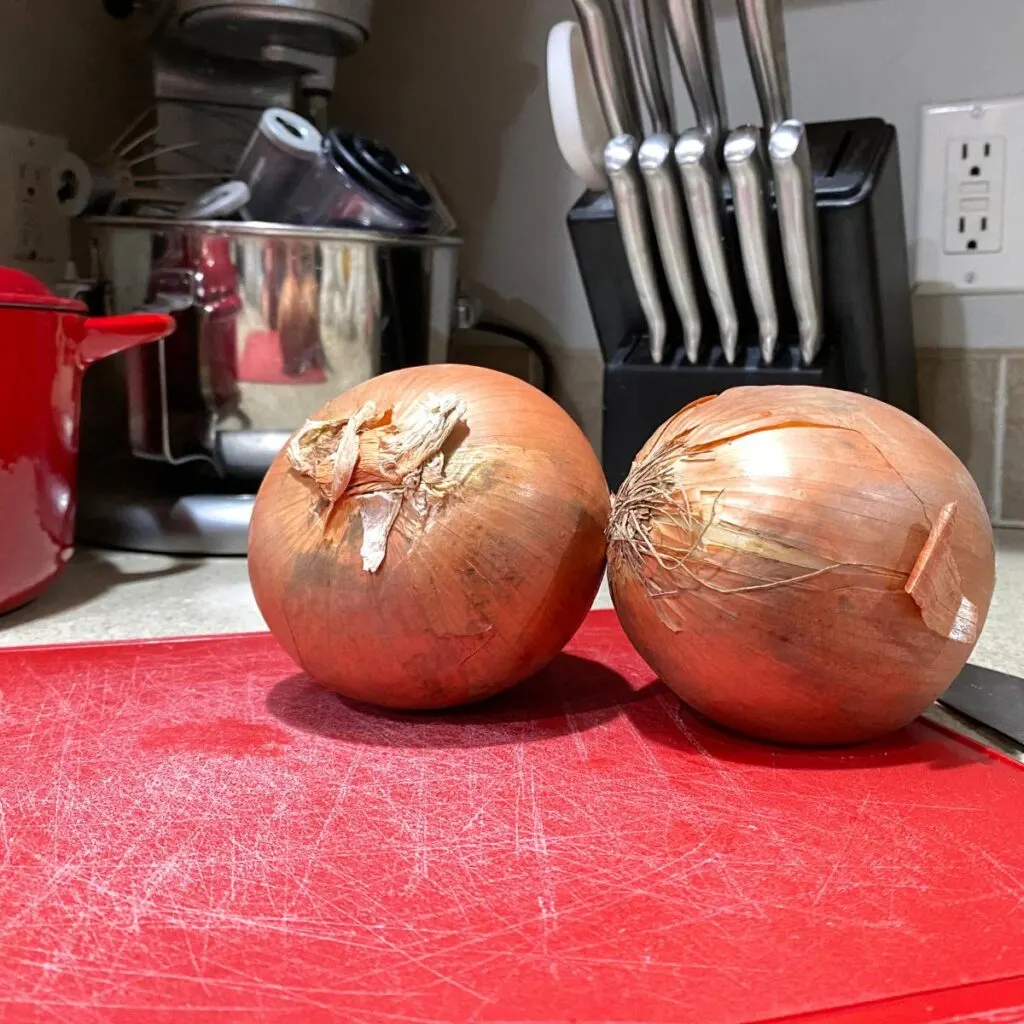
First, you will want to choose your onions and peel them. I decided to start out with two as I knew I would have to do multiple batches. These two large onions filled three and a half of my dehydrator trays.
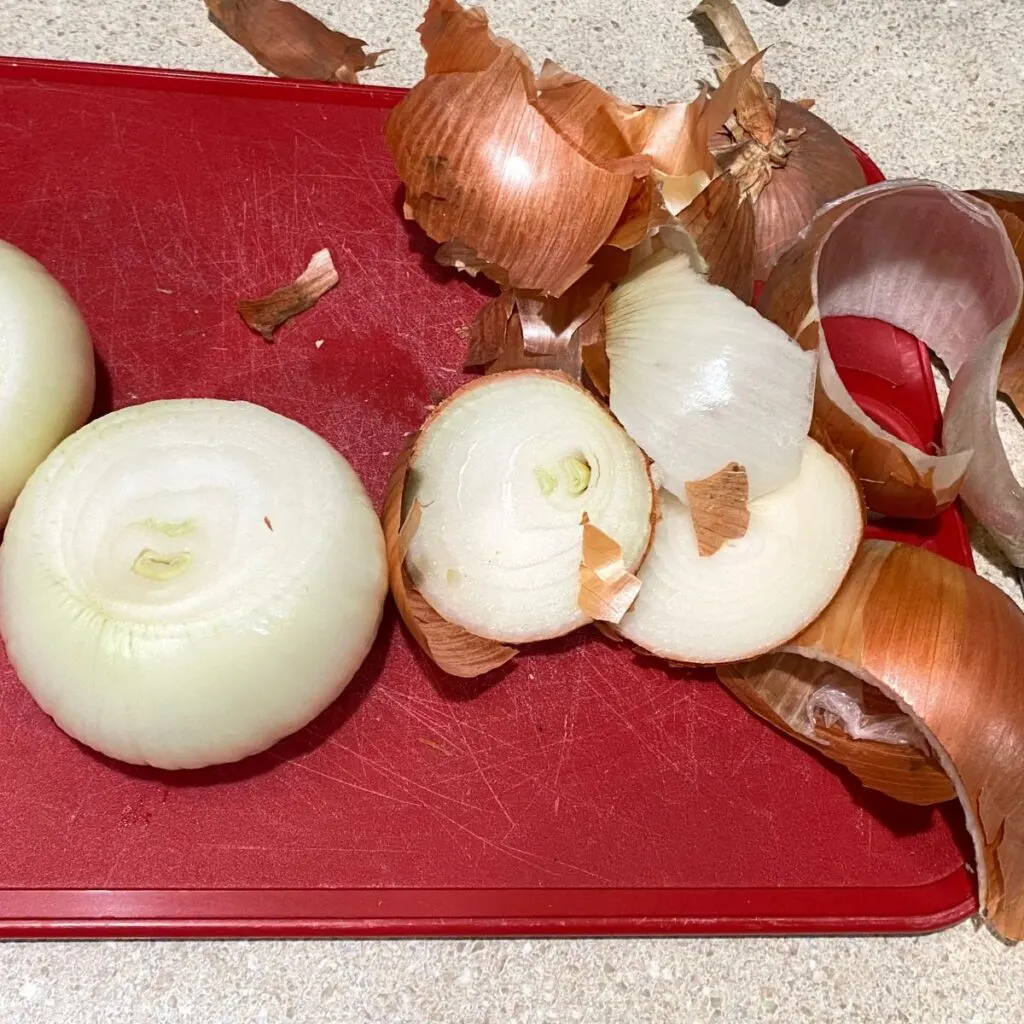
BONUS TIP: You can also decrease your food waste with this project by using the onion’s peels. Save those outer layers by storing in the freezer until you have enough vegetable scraps to make vegetable broth! I absolutely love the taste and beautiful amber color the onion peels give to my homemade broth. I don’t even season it!
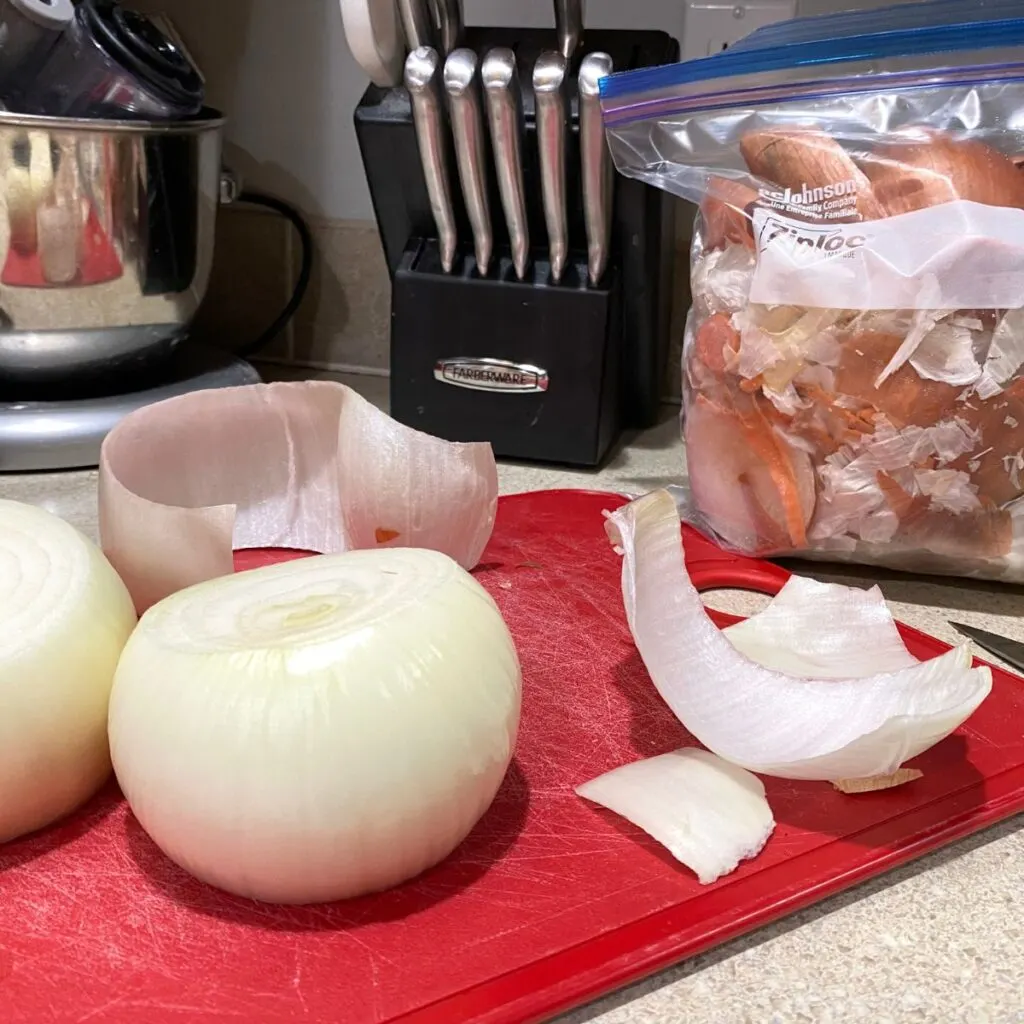
After peeling the onions, it was time to decide how to slice them. I first started by peeling them layer by layer and cutting each layer into fourths before slicing any thinner. It is important to get as uniform of slices as you can, otherwise the drying times will vary and this will complicate your project (as it did mine the first time!).

I then sliced each of the four parts of one layer into multiple little strips like this. I figured the thinner they were, the easier it would be for them to dehydrate, as onions hold a lot of moisture.
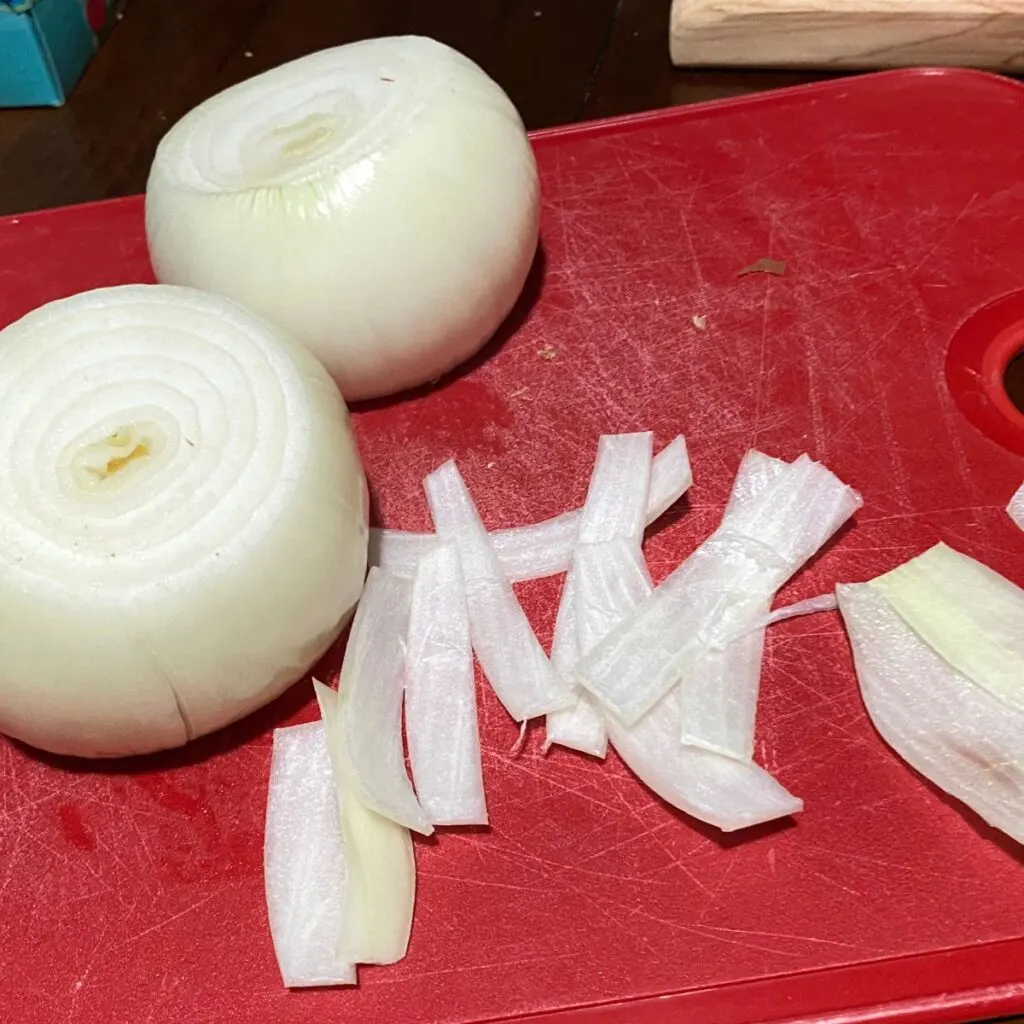
After a couple of batches with the thin slices, I decided I liked having thicker slices. They held up better and although it took longer for them to dehydrate, I was able to handle them a little easier. This is simply my preference, however, because if you are going to be blending it into a fine homemade onion powder, it really doesn’t matter what size they are.
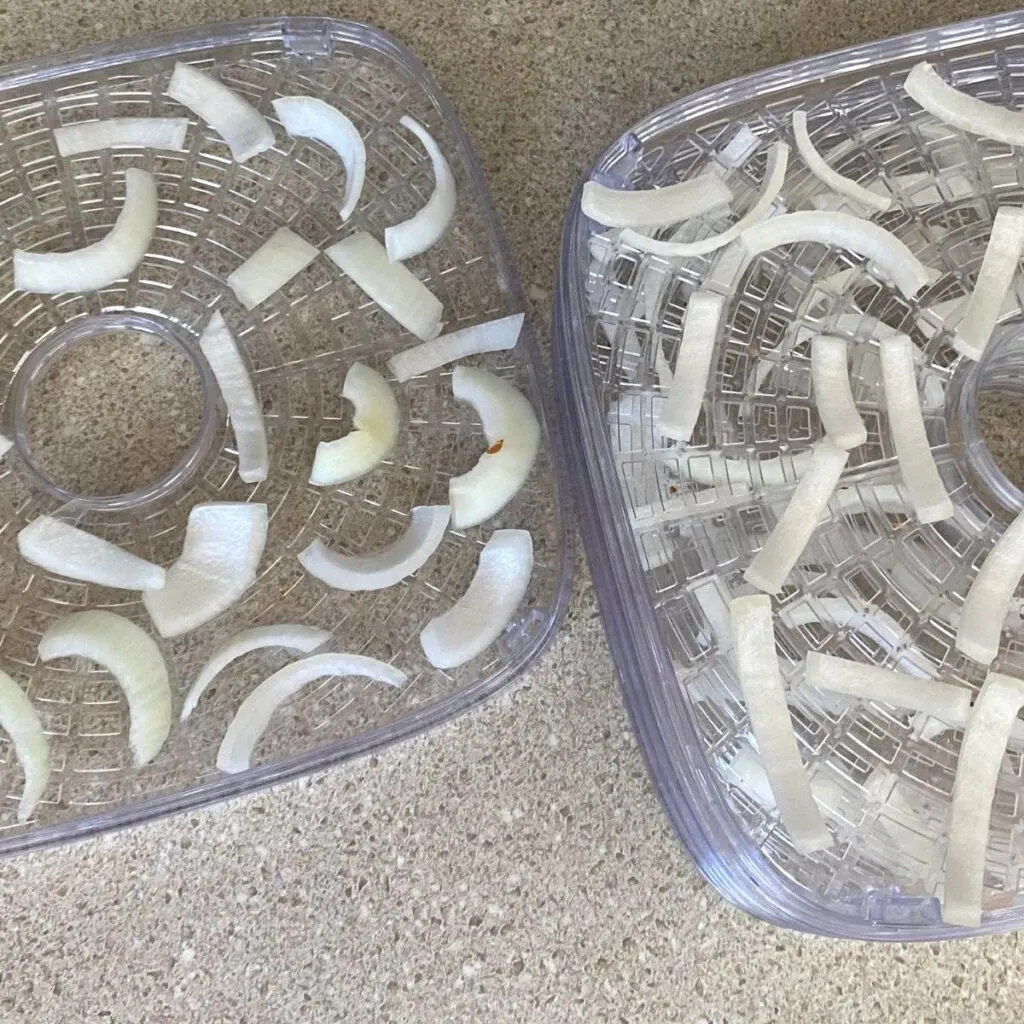
To dehydrate, I set them at 148 degrees for eight hours in the garage. The smell was rather strong, but with the door closed, it only permeated our mudroom/laundry room area right on the other side of the door. I would not suggest dehydrating onions (or garlic for that matter) in your home as it is a very powerful smell. If you can wait to dehydrate onions when you can do it outside, that would be the best option.
When I pulled the onions out after the eight hours, they were a bit rubbery but had shrunk quite a bit. I put them back at 148 degrees for another four hours and this was perfect.
If your slices are thinner, you could get away with a higher temperature (around 150°) for eight hours and it should be good to go. I think the bigger slices took longer and my temperature was not high enough to draw out the moisture in less time.
Taking dehydrated onions and making homemade onion powder
Once the time has lapsed and the onion slices seem dried, test them by breaking one with your fingers. They should easily snap in half rather than bend. If they bend and do not give a sharp, clean break, then they need to be returned to the dehydrator as they are not fully dried. In my experiment process, I had to return my onions to the dehydrator three times. This was my first time after all and it takes patience and practice to learn a new skill! So don’t be discouraged if you don’t get them fully dried the first try.
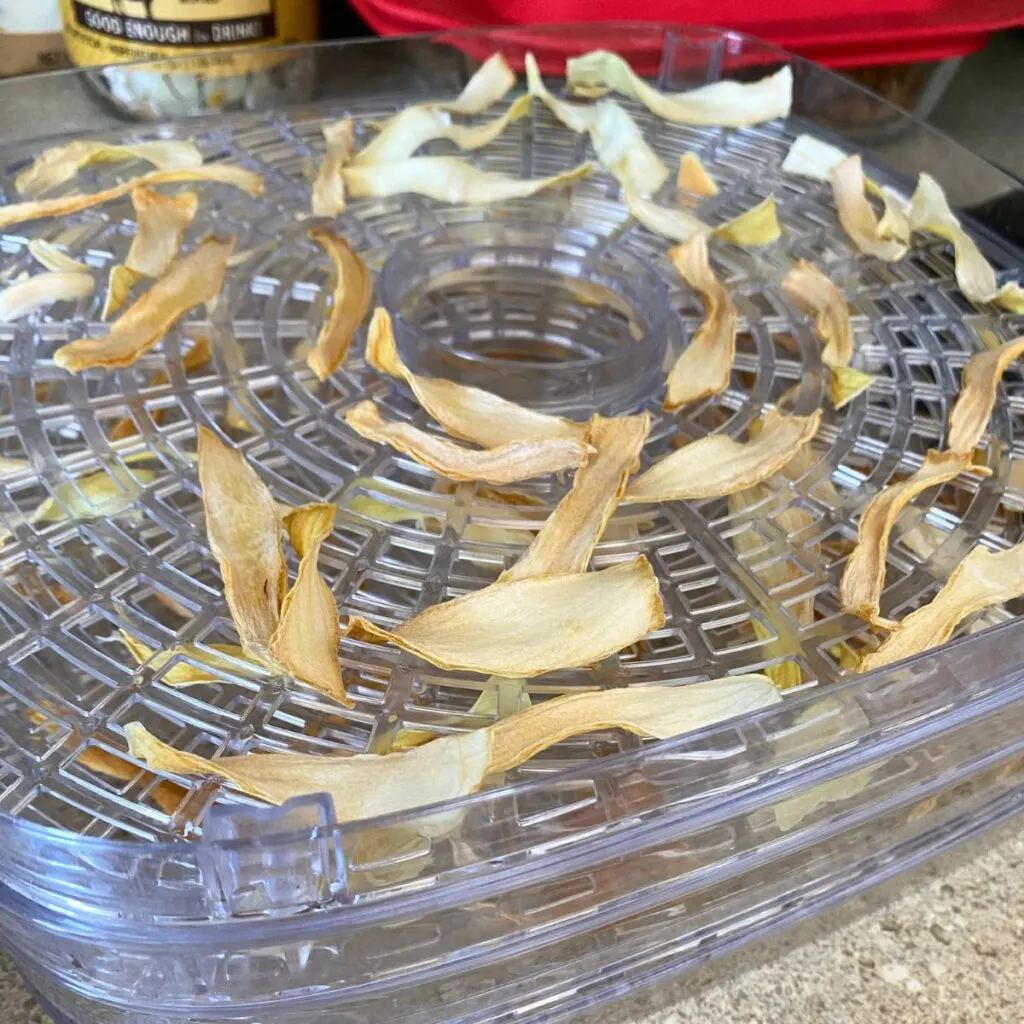
Your finished product will be delicious dehydrated onion flakes that you can use as a garnish on green bean casserole if you’re looking for a healthier alternative to the traditional fried onion crispies or you can chop to be used as dried minced onions like you find in the store.
If you are seeking to turn those dried onions into flavorful and nutritious onion powder, then it is time to follow this easy three-step process detailed below.

Step one: The moisture test
Before storing any dehydrated good for long-term storage, or in our case before grinding it up to make homemade onion powder, you should conduct a moisture test. The moisture test is a simple process that ensures your product is dehydrated fully. This is an important step, otherwise the product could mold.
To conduct the moisture test, add your dehydrated onion pieces to a glass jar and seal with a lid and ring. Wait a day or two to see if any moisture gathers on the sides of the jar or the underside of the lid. If there is no moisture, then you are in the clear to move on to the next step. If there is, stick your onion pieces back into the dehydrator until fully dried.
As I opened the mason jars after the moisture test to put them in the blender, the aroma of the onions was very strong and delectable. I had high hopes that the powder’s flavor would be stronger and richer than what you purchase at the store and I was not disappointed.
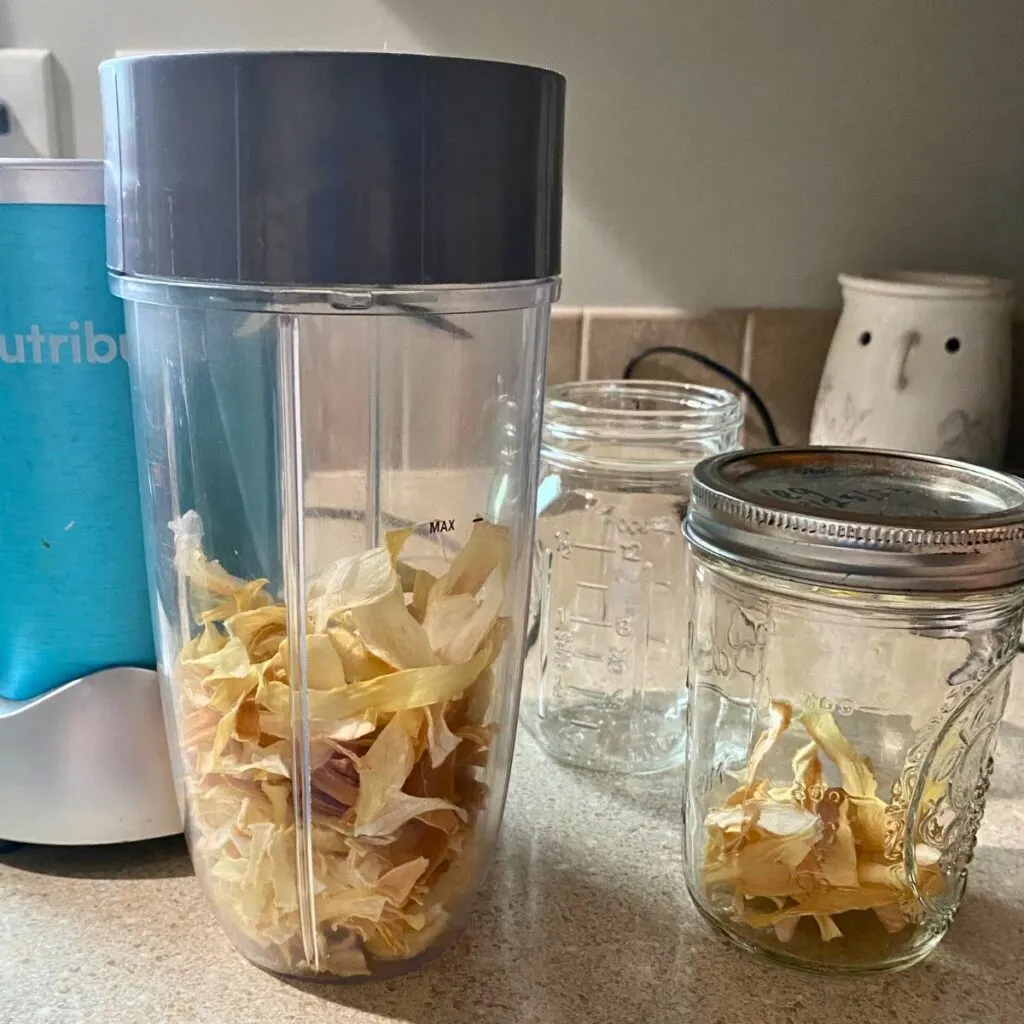
Step two: Blend to your preference
Add your dehydrated onion pieces into your blender and begin. Take note, you may have to start and stop multiple times to determine how much to grind it down, as the dust kicks up very quickly.
I decided to leave my onion powder a little more on the coarse side as we like different textures in our food. At first, I blended the onion pieces for around four seconds. The dust was so thick I needed to stop to see how much it had been ground. I then blended it for another five seconds and was happy with the grain so I stopped. If you wanted your homemade onion powder to be extremely fine, twelve to fifteen seconds should get you there.
Step three: Store in a dry place and use within a year
For best results, store your homemade onion powder in an airtight container (like wide-mouthed mason jars to easily spoon out your desired measurement) and in a dry place out of direct sunlight. This powder will have a shelf life of over a year, but use within a year for best quality, nutrition, and flavor.
Because I was experimenting with this process for the first time, I only used about four whole onions. I ultimately made a little less than a half cup of homemade onion powder.
For a future project, I would like to purchase onions in bulk and make enough to last us much longer. Though the process was not extremely labor intensive, it did take some time for the onions to be sliced and dehydrated and the garage did smell to high heaven for a couple of days. I prefer to prep in batches so that I am not constantly maintaining the same food items but have a greater variety in my homesteading routine. This is simply my preference, however, and this is a project that could be added in to a regular homemaking routine fairly easily.
Use homemade onion powder the same way you would use the store-bought kind, though you may have to test how much you need to use depending on how powerful the onion flavor comes through. I would start with half of what you normally use and up the measurement from there if the onion is not strong enough for your taste.

Steps I will use in the future to dehydrate onions
In sum, these are the following steps I will be using to dehydrate onions and make homemade onion powder in the future:
- Peel and cut raw onions and save the outer layers in the freezer to make homemade broth
in the future - Cut off each end of the onion and peel layer by layer
- Slice each layer into one inch strips and place in a single layer on the dehydrator trays
- Set dehydrator at a temp of 150° or higher (my dehydrator has options for 148° or 159°,
so I will use the higher temperature) for ten to twelve hours - Test dehydrated onion pieces by breaking in half and then conducting the moisture test
for a day - Place dehydrated onions into a blender for eight seconds or until the onion powder is the
grain I prefer - Store homemade onion powder in an airtight container like a mason jar for up to a year
Other uses for dehydrated onions
If you have previously read Shannon’s post on how to harvest and preserve green onions, then you can see that the process for dehydrating other types of onions are pretty similar. The thicker slices (or rings) tend to do better when dehydrating than the thinner, though it does take more time in the dehydrator. But what can you do with these onions if you don’t want to use them for homemade onion powder?
The first option is to leave the dehydrated pieces in slices and use as a garnish for different dishes. I am planning on keeping some of my onion slices in their current form to try on mashed potatoes for a fun texture. I believe you could also use them in any dish you would use diced onions in, though I have not personally tried this (yet).
Benefits of preserving onions on your homestead
Onions are a true workhorse in the kitchen and medicine cabinet. They are wonderful to have on hand for a variety of purposes and uses. Therefore, it is wise to use multiple preservation methods for your onions to ensure you always have them in your pantry in one form or another. Whether your preference is to dehydrate or freeze them, I hope you choose to try homemade onion powder at least once. The flavor is much more intense and delicious than the store-bought alternative! It is perfect for a quick and easy soup, like my family’s favorite: potato soup with bacon and cheese! It may take a few tries to get it right, but I believe once you do, you’ll never go back.
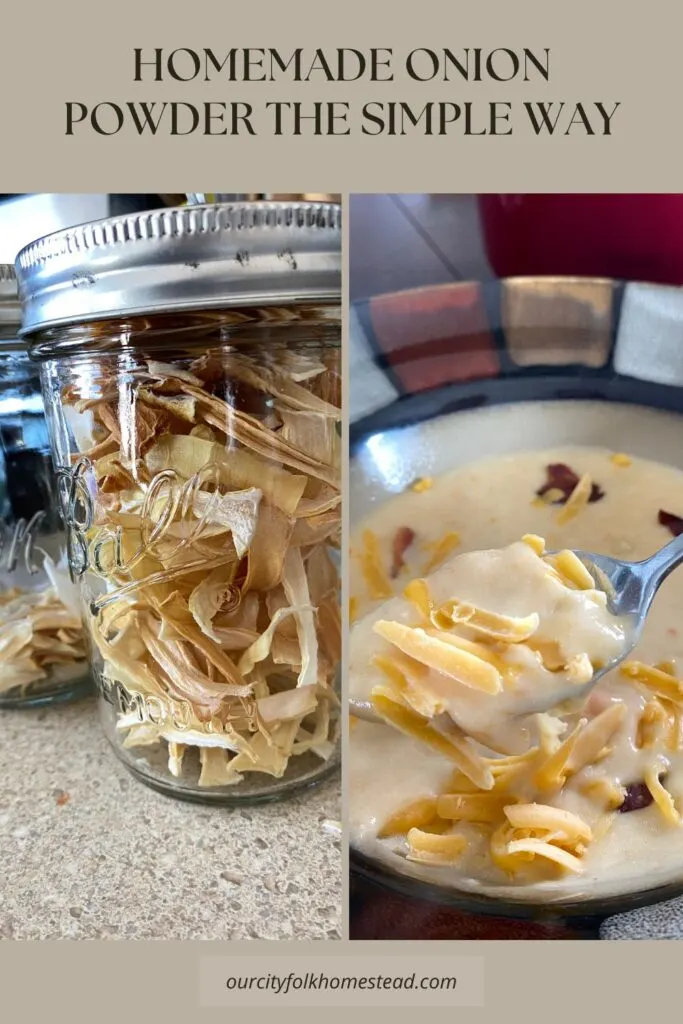
More from City Folk Homestead:
Grocery Budget Tips for a Frugal Homestead with Young Kids
Winter Chicken Coop Bedding for Keeping Chickens Warm
How To DIY This Simple Citrus-Scented Vinegar!
Moist Fifth Generation Pumpkin Bread Recipe With Coconut Oil
